1998 GMC SIERRA transmission
[x] Cancel search: transmissionPage 102 of 452

Manual Transmission Operation
5-Speed (MW3 Transmission with
Low Gear) (If Equipped)
Here’s how to operate
your transmission.
FIRST
(1) is intended only for heavy loads and is not
recommended for normal driving.
During the first
500 miles (805 km) of vehicle use, start
your vehicle moving in
FIRST (1). This allows clutch
components to break-in properly.
FIRST (1): Press the clutch pedal and shift into
FIRST
(1). Then, slowly let up on the clutch pedal as
you press the accelerator pedal. Shift into FIRST (1)
only when the vehicle is below 5 rnph (8 kdh). If you try to
shift down into
FIRST (1) at excessive vehicle
speeds, the shift lever
will not move into the FIRST ( 1 )
position until vehicle speed is reduced.
SECOND (2): Press the clutch pedal and shift into
SECOND
(2). Then, slowly let up on the clutch pedal as
you press the accelerator pedal.
You can shift into SECOND
(2) when you‘re going less
than
20 mph (32 kndh). If you’ve come to a complete stop
and it’s hard to shift into SECOND
(2), put the shift lever
into NEUTRAL
(N) and let up on the clutch. Press the
clutch pedal back clown. Then shift into SECOND
(2). If
you try to downshift into SECOND (2) at excessive
vehicle speeds, the shift lever will not move into
the
SECOND (2) position until the vehicle speed is reduced.
THIRD (3): Press the clutch pedal and shift into
THIRD (3). Then, slowly let LIP on the clutch pedal as
you press the accelerator pedal.
FOURTH (4) and FIFTH (5): Shift into the higher
forward gears the same way you do for THIRD
(3).
Slowly let up on the clutch pedal as you press the
accelerator pedal.
To stop, let
up on the accelerator pedal and press the brake
pedal. Just before the vehicle stops. press the clutch pedal
and the brake pedal, and shift to NEUTRAL (N).
2-18
ProCarManuals.com
Page 103 of 452

NEUTRAL (N): Use this position when you start or
idle your engine.
REVERSE (R): To back up, first press down the clutch
pedal. Wait about five seconds for the internal parts to stop
spinning and then, shift into REVERSE (R).
Let up on the
clutch pedal slowly while pressing the accelerator pedal.
I NOTICE:
Shift to REVERSE (R) only after your vehicle is
stopped. Shifting
to REVERSE (R) while your
vehicle is moving could damage
your transmission.
Also, use REVERSE (R), along with the parking brake,
when turning off your engine and parking your vehicle.
5-Speed (MG5M50 Transmission without
Low Gear) (If Equipped)
Here’s how to operate your transmission:
FIRST (1): Press the clutch pedal and shift into
FIRST
(1). Then, slowly let up on the clutch pedal as
you press the accelerator pedal. You
can shift into FIRST
(1) when you’re going less
than
20 mph (32 km/h). If you’ve come to a complete
stop and
it’s hard to shift into FIRST (l), put the shift
lever into NEUTRAL
(N) and let up on the clutch. Press
the clutch pedal back down. Then shift into FIRST
(I).
SECOND (2): Press the clutch pedal as you let up on
the accelerator pedal and shift into
SECOND (2). Then,
slowly let up on the clutch pedal
as you press the
accelerator pedal.
THIRD (3), FOURTH (4) and FIFTH (5): Shift into
THIRD
(3), FOURTH (4) and FIFTH (5) the same way
you do for SECOND (2). Slowly let up on the clutch
pedal
as you press the accelerator pedal.
To stop, let up on the accelerator pedal and
press the brake pedal. Just before the vehicle stops,
press the clutch pedal and the brake pedal, and shift to
NEUTRAL
(N).
NEUTRAL (N): Use this position when you start or
idle your engine.
REVERSE (R): To back up, first press down the clutch
pedal. Wait about five seconds
for the internal parts to stop
spinning and then, shift
into REVERSE (R). Let up on the
clutch pedal slowly while pressing the accelerator pedal.
2-19
ProCarManuals.com
Page 104 of 452
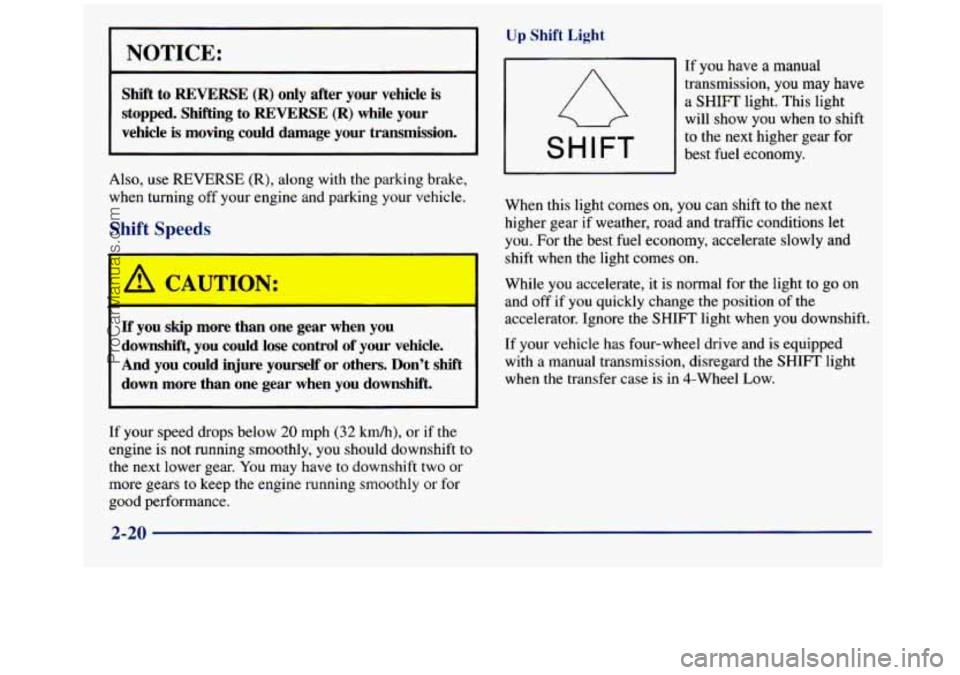
NOTICE:
Up Shift Light
4l
If you have a manual
Shift to REVERSE (R) only after your vehicle is transmission, you may have
a SHIFT light. This light
stopped. Shifting to REVERSE (R) while your
vehicle is moving could damage your transmission. will show you when to shift
best fuel economy.
to the next higher gear for
SHIFT
AI - - , use REVERSE (R), along with the parking brake,
when turning
off your engine and parking your vehicle.
Shift Speeds
I JOU skip more than one gear when you
downshift, you could lose control
of your vehicle.
And you could injure yourself or others. Don’t shift
down more than one gear when you downshift.
If your speed drops below 20 mph (32 kmh), or if the
engine
is not running smoothly, you should downshift to
the next lower gear. You may have to downshift two or
more gears to keep the engine running smoothly or for
good performance. When
this light comes on,
you can shift to the next
higher gear if weather, road and traffic conditions let
you. For the best fuel economy, accelerate slowly and
shift when the light comes on.
While
you accelerate, it is normal for the light to go on
and
off if you quickly change the position of the
accelerator. Ignore the
SHIFT light when you downshift.
If your vehicle has four-wheel drive and
is equipped
with a manual transmission, disregard the SHIFT light
when
the transfer case is in 4-Wheel Low.
I
2-20
ProCarManuals.com
Page 106 of 452

I ~ The front axle portion of the indicator diagram will light
up when you shift into four-wheel drive and the front
axle engages.
Some delay between shifting and the indicator’s lighting
is normal. If the front axle light does not go out
immediately after you shift out of four-wheel drive,
1 have your dealer check your system.
An indicator near the lever shows you the transfer
case settings:
2-Wheel High (2H): This setting is for driving in most
street and highway situations. Your front axle is not
engaged in two-wheel drive. 4-Wheel High
(4H): This setting engages your front
axle to help drive your vehicle. Use
4H when you need
extra traction and in most off-road situations.
Shifting the transfer case to
NEUTRAL (N) can
cause your vehicle to roll even
if the transmission
is in
PARK (P), or if you have a manual
transmission, even if you are in gear. You or
someone else could be seriously injured. Be
sure
to set the parking brake before placing the
transfer case in
NEUTRAL (N). See “Parking
Brake” in the Index.
NEUTRAL (N): Shift to this setting only when your
vehicle needs to be towed or when using a power take-off.
4-Wheel
Low (4L): This setting also engages your front
axle to give you extra power and also gives you
a higher
driveline ratio. It should be used only for off-road driving.
2-22
ProCarManuals.com
Page 107 of 452
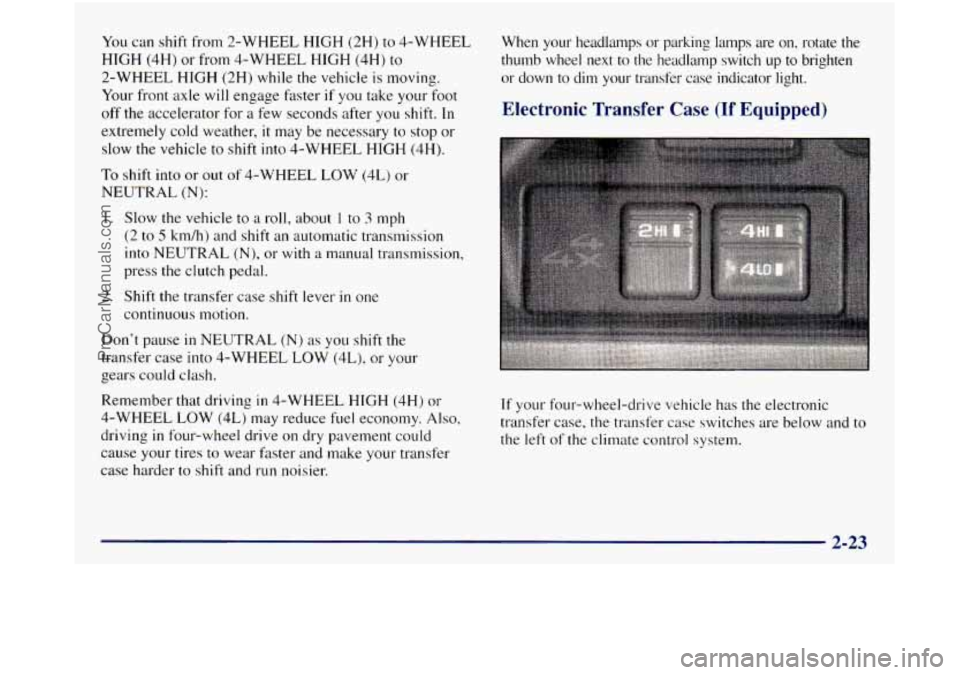
You can shift from 2-WHEEL HIGH (2H) to 4-WHEEL
HIGH (4H) or from 4-WHEEL HIGH (4H) to
2-WHEEL HIGH (2H) while
the vehicle is moving.
Your front axle will engage faster
if you take your foot
off the accelerator for a few seconds after you shift. In
extremely cold weather, it may be necessary to stop or
slow the vehicle
to shift into 4-WHEEL HIGH (4H).
To
shift into or out of 4-WHEEL LOW (4L) or
NEUTRAL
(N):
1. Slow the vehicle to a roll, about 1 to 3 mph
(2
to 5 km/h) and shift an automatic transmission
into NEUTRAL
(N), or with a manual transmission,
press the clutch pedal.
2. Shift
the transfer case shift lever in one
continuous motion.
Don’t pause
in NEUTRAL (N) as you shift the
transfer case into 4-WHEEL LOW (4L), or your
gears
could clash.
Remember that driving
in 4-WHEEL HIGH (4H) or
4-WHEEL LOW (4L) may reduce
fuel economy. Also,
driving
in four-wheel drive on dry pavement could
cause your tires to wear faster and make your transfer
case harder
to shift and run noisier. When your headlamps
or parking lamps are on, rotate the
thumb wheel next
to the headlamp switch up to brighten
or down to dim your transfer case indicator light.
Electronic Transfer Case (If Equipped)
If your four-wheel-drive vehicle has the electronic
transfer case,
the transfer case switches are below and to
the left of the climate control system.
2-23
ProCarManuals.com
Page 108 of 452
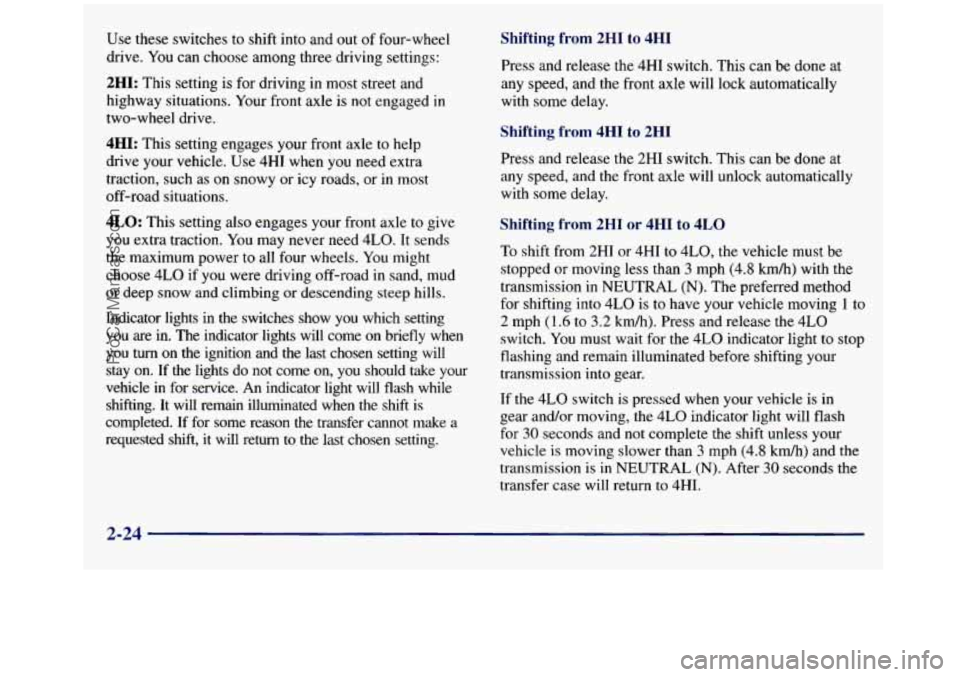
Use these switches to shift into and out of four-wheel
drive. You can choose among three driving settings:
2HI: This setting is for driving in most street and
highway situations. Your front axle is not engaged
in
two-wheel drive.
4HI: This setting engages your front axle to help
drive your vehicle. Use 4HI when you need extra
traction, such as
on snowy or icy roads, or in most
off-road situations.
4LO: This setting also engages your front axle to give
you extra traction. You may never need 4LO. It sends
the maximum power to all
four wheels. You might
choose 4LO if you were driving off-road in sand, mud
or deep snow and climbing or descending steep hills.
Indicator lights in the switches show you which setting
you are in. The indicator lights will come on briefly when
you
turn on the ignition and the last chosen setting will
stay on. If the lights
do not come on, you should take your
vehicle in for service. An indicator light will flash while
shifting. It will remain illuminated when
the shift is
completed. If for some reason the transfer cannot make a
requested shift, it will return
to the last chosen setting.
Shifting from 2HI to 4HI
Press and release the 4HI switch. This can be done at
any speed, and the front axle will lock automatically
with some delay.
Shifting from 4HI to 2HI
Press and release the 2HI switch. This can be done at
any speed, and the front axle will unlock automatically
with some delay.
ting from 2HI or 4HI to 4LO
'li hift from 2HI or 4HI to 4L0, the vehicle must be
stopped or moving less than
3 mph (4.8 km/h) with the
transmission in
NEUTRAL (N). The preferred method
for shifting into 4LO is to have your vehicle moving
1 to
2 mph (1.6 to
3.2 kmh). Press and release the 4LO
switch. You must wait for the
4LO indicator light to stop
flashing and remain illuminated before shifting your
transmission into gear.
If the 4LO switch is pressed when your vehicle is in
gear and/or moving, the 4LO indicator light will flash
for 30 seconds and not complete the shift unless your
vehicle is moving slower than
3 mph (4.8 kmh) and the
transmission is
in NEUTRAL (N). After 30 seconds the
transfer case will return to 4HI.
2-24
ProCarManuals.com
Page 109 of 452
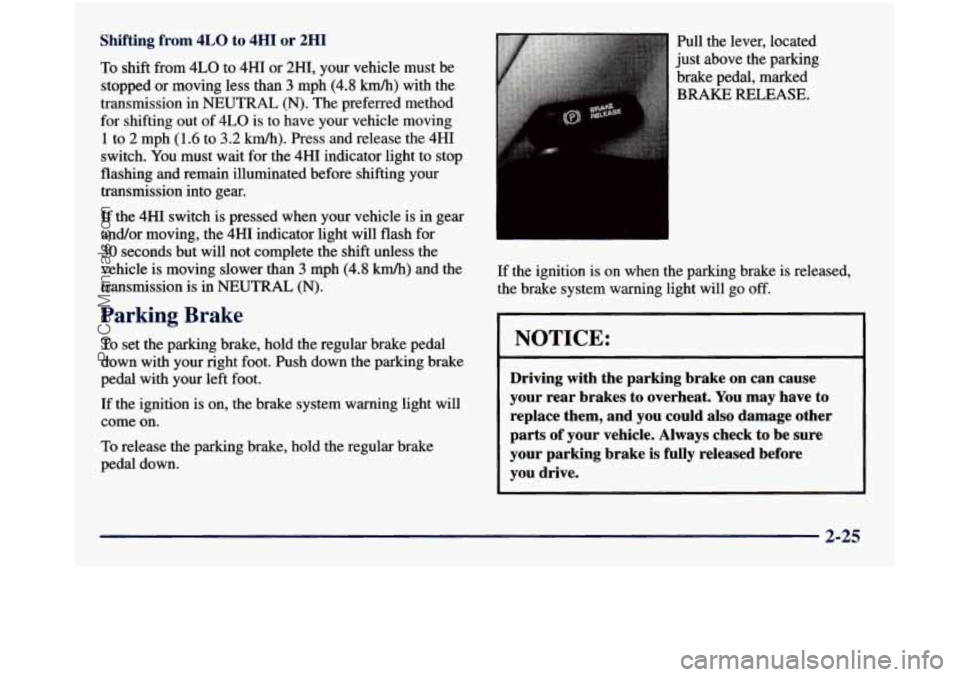
Shifting from 4LO to 4HI or 2HI
To shift from 4LO to 4HI or 2H1, your vehicle must be
stopped or moving less than
3 mph (4.8 km/h) with the
transmission in
NEUTRAL (N). The preferred method
for shifting out of
4LO is to have your vehicle moving
1 to 2 mph (1.6 to 3.2 km/h). Press and release the 4HI
switch. You must wait for the 4HI indicator light to stop
flashing and remain illuminated before shifting your
transmission into gear.
If the 4HI switch is pressed when your vehicle is in gear
and/or moving, the
4HI indicator light will flash for
30 seconds but will not complete the shift unless the
vehicle is moving slower than
3 mph (4.8 km/h) and the
transmission is in
NEUTRAL (N).
Parking Brake
To set the parking brake, hold the regular brake pedal
down with your right foot. Push down the parking brake
pedal with your left foot.
If the ignition is on, the brake system warning light will
come on.
To release the parking brake, hold the regular brake
pedal down. Pull
the lever, located
just above the parking
brake pedal, marked
BRAISE RELEASE.
If the ignition is on when the parking brake is released,
the brake system warning light will go off.
NOTICE:
Driving with the parking brake on can cause
your rear brakes to overheat. You may have to
replace them, and you could also damage other
parts of your vehicle. Always check to be sure
your parking brake is fully released before
you drive.
2-25
ProCarManuals.com
Page 110 of 452
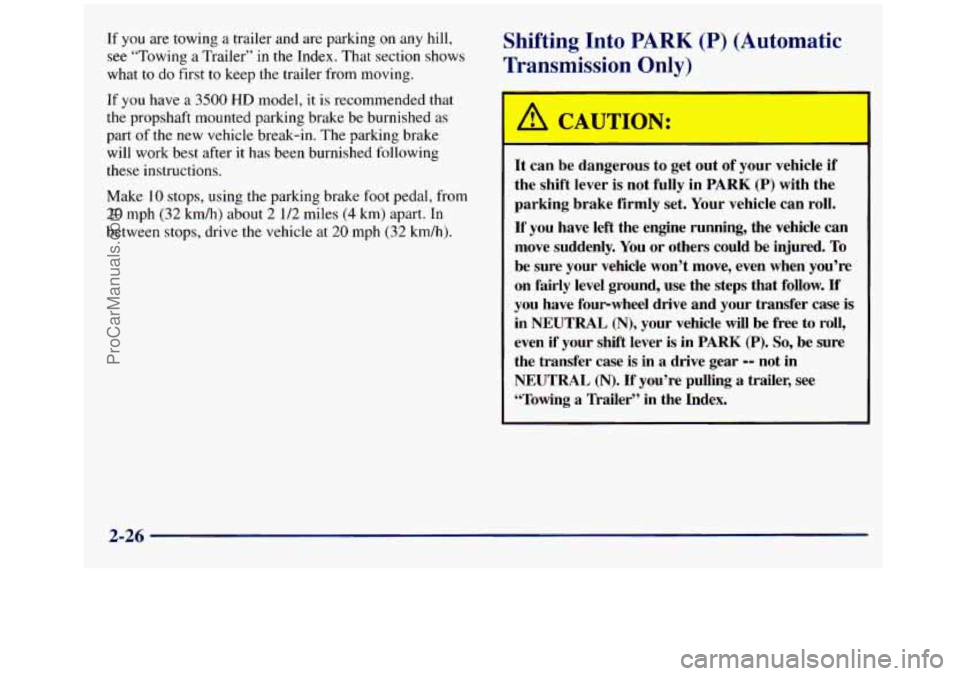
If you are towing a trailer and are parking on any hill,
see “Towing a Trailer” in the Index. That section shows
what to do first
to keep the trailer from moving.
Shifting Into PARK (P) (Automatic
Transmission Only)
If you have a 3500 HD model, it is recommended that
the propshaft mounted parking brake be burnished
as
part of the new vehicle break-in. The parking brake
will work best after
it has been burnished following
these instructions.
Make
10 stops, using the parking brake foot pedal, from
20 mph (32 kmh) about 2 1/2 miles (4 km) apart. In
between stops, drive the vehicle at
20 mph (32 km/h).
A CAUTION:
-
It can be dangerous to get out of your vehicle if
the shift lever is not fully in PARK (P) with the
parking brake firmly
set. Your vehicle can roll.
If you have left the engine running, the vehicle can
move suddenly. You
or others could be injured. To
be sure your vehicle won’t move, even when you’re
on fairly level ground, use the steps that follow.
If
you have fourwheel drive and your transfer case is
in
NEUTRAL (N), your vehicle will be free to roll,
even
if your shift lever is in PARK (P). So, be sure
the transfer case is in a drive gear
-- not in
NEUTRAL (N). If you’re pulling a trailer, see
“Towing a Trailer” in the Index.
2-26
ProCarManuals.com